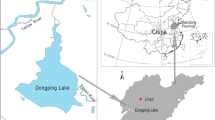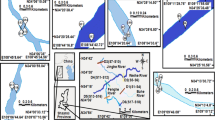Abstract
We evaluated organic pollution in Bosten Lake, Xinjiang, China, by measuring the concentrations and distributions of organochlorine pesticides (OCPs) and polycyclic aromatic hydrocarbons (PAHs). Water and sediment samples were collected from 19 sites (B1–B19) in the lake for analysis. Our analytical results show that the concentrations of total OCPs in water ranges from 30.3 to 91.6 ng/L and the concentrations of PAHs ranges from undetectable (ND) to 368.7 ng/L. The concentrations of total OCPs in surface (i.e., lake bottom) sediment ranges from 6.9 to 16.7 ng/g and the concentrations of PAHs ranges from 25.2 to 491.0 ng/g. Hexachlorocyclohexanes (HCHs) and dichlorodiphenyltrichloroethanes (DDTs) account for large proportions of the OCPs. Low α- to γ-HCH ratios in both water and sediment samples indicate possible contributions from both industrial products and lindane. DDTs in water are probably from historical input, whereas DDTs in sediments are from both historical and recent inputs. Moreover, DDT products in both water and sediments were from multiple sources in the northwestern part of the lake (B11, B12, B13, and B14). Fugacity ratios for DDT isomers (p,p′-DDE and p,p′-DDT) at these sites were generally higher than equilibrium values. These results suggest that the input from the Kaidu River and diffusion of DDTs from the sediment to the water are responsible for DDT pollution in the water. Lower-molecular-weight PAHs, which originate primarily from wood and coal combustion and petroleum sources, represent the major fraction of the PAHs in both water and sediment samples. Our findings indicate that OCPs and PAHs in Bosten Lake can be attributed primarily to human activities. A risk assessment of OCPs and PAHs in water and sediment from Bosten Lake, however, suggests that concentrations are not yet high enough to cause adverse biological effects on the aquatic ecosystem.
Similar content being viewed by others
References
Arienzo M, Albanese S, Lima A, et al. 2015. Assessment of the concentrations of polycyclic aromatic hydrocarbons and organochlorine pesticides in soils from the Sarno River basin, Italy, and ecotoxicological survey by Daphnia magna. Environmental Monitoring and Assessment, 187(2): 1–14.
Dai G, Liu X, Liang G, et al. 2011. Distribution of organochlorine pesticides (OCPs) and poly chlorinated biphenyls (PCBs) in surface water and sediments from Baiyangdian Lake in North China. Journal of Environmental Sciences, 23(10): 1640–1649.
Dai G, Liu X, Liang G, et al. 2014. Evaluating the exchange of DDTs between sediment and water in a major lake in North China. Environmental Science and Pollution Research, 21(6): 4516–4526.
Francu E, Schwarzbauer J, Lána R, et al. 2010. Historical changes in levels of organic pollutants in sediment cores from Brno Reservoir, Czech Republic. Water, Air and Soil Pollution, 209(1–4): 81–91.
Guo J, Wu F, Luo X, et al. 2010. Anthropogenic input of polycyclic aromatic hydrocarbons into five lakes in western China. Environmental Pollution, 158(6): 2175–2180.
Harrison R M, Smith D J T, Luhana L. 1996. Source apportionment of atmospheric polycyclic aromatic hydrocarbons collected from an urban location in Birmingham, UK. Environmental Science and Technology, 30(3): 825–832.
Helm P A, Milne J, Hiriart-Baer V, et al. 2011. Lake-wide distribution and depositional history of current-and past-use persistent organic pollutants in Lake Simcoe, Ontario, Canada. Journal of Great Lakes Research, 37: 132–141.
Iwata H, Tanabe S, Ueda K, et al. 1995. Persistent organochlorine residues in air, water, sediments, and soils from the lake Baikal region, Russia. Environmental Science and Technology, 29(3): 792–801.
Khairy M A, Lohmann R. 2012. Field validation of polyethylene passive air samplers for parent and alkylated PAHs in Alexandria, Egypt. Environmental Science and Technology, 46(7): 3990–3998.
Kim K H, Jahan S A, Kabir E, et al. 2013. A review of airborne polycyclic aromatic hydrocarbons (PAHs) and their human health effects. Environment International, 60: 71–80.
Li C, Huo S, Yu Z, et al. 2014. Spatial distribution, potential risk assessment, and source apportionment of polycyclic aromatic hydrocarbons (PAHs) in sediments of Lake Chaohu, China. Environmental Science and Pollution Research, 21(20): 12028–12039.
Lin T, Hu Z, Zhang G, et al. 2009. Levels and mass burden of DDTs in sediments from fishing harbors: the importance of DDT-containing antifouling paint to the coastal environment of China. Environmental Science and Technology, 43: 8033–8038.
Liu W X, He W, Qin N, et al. 2013. The residues, distribution, and partition of organochlorine pesticides in the water, suspended solids, and sediments from a large Chinese lake (Lake Chaohu) during the high water level period. Environmental Science and Pollution Research, 20(4): 2033–2045.
Liu X, Xu M, Yang Z, et al. 2010. Sources and risk of polycyclic aromatic hydrocarbons in Baiyangdian Lake, North China. Journal of Environmental Science and Health Part A, 45(4): 413–420.
Liu Y, Yu N, Li Z, et al. 2012. Sedimentary record of PAHs in the Liangtan River and its relation to socioeconomic development of Chongqing, Southwest China. Chemosphere, 89(7): 893–899.
Liu Y, Mu S, Bao A, et al. 2015. Effects of salinity and (an) ions on arsenic behavior in sediment of Bosten Lake, Northwest China. Environmental Earth Sciences, 73(8): 4707–4716.
Lu M, Zeng D C, Liao Y, et al. 2012. Distribution and characterization of organochlorine pesticides and polycyclic aromatic hydrocarbons in surface sediment from Poyang Lake, China. Science of the Total Environment, 433: 491–497.
Ma L, Wu J, Abuduwaili J. 2011. The climatic and hydrological changes and environmental responses recorded in lake sediments of Xinjiang, China. Journal of Arid Land, 3(1): 1–8.
MacDonald D D, Ingersoll C G, Berger T A. 2000. Development and evaluation of consensus-based sediment quality guidelines for freshwater ecosystems. Archives of Environmental Contamination and Toxicology, 39(1): 20–31.
Mackay D. 2001. Multimedia Environmental Models: the Fugacity Approach (2nd ed.) CRC Press: Boca Raton, 69–232.
Montuori P, Triassi M. 2012. Polycyclic aromatic hydrocarbons loads into the Mediterranean Sea: estimate of Sarno River inputs. Marine Pollution Bulletin, 64: 512–520.
Montuori P, Cirillo T, Fasano E, et al. 2014. Spatial distribution and partitioning of polychlorinated biphenyl and organochlorine pesticide in water and sediment from Sarno River and Estuary, Southern Italy. Environmental Science and Pollution Research, 21(7): 5023–5035.
National Bureau of Statistics of China. 2009. China Statistical Yearbook 2009. Beijing: China Statistics Press. (in Chinese)
Ogata M, Fujisawa K. 1990. Gas chromatographic and capillary gas chromatographic/mass spectrometric determination of organic sulfur compounds in sediment from ports: significance of these compounds as an oil pollution index. Bulletin of Environmental Contamination and Toxicology, 44(6): 884–891.
Ok G, Shirapova G, Matafonova G, et al. 2013. Characteristics of PAHs, PCDD/Fs, PCBs and PBDEs in the sediment of Lake Baikal, Russia. Polycyclic Aromatic Compounds, 33: 173–192.
Qiu X, Zhu T, Li J, et al. 2004. Organochlorine pesticides in the air around the Taihu Lake, China. Environmental Science and Technology, 38(5): 1368–1374.
Qiu X, Zhu T, Yao B, et al. 2005. Contribution of dicofol to the current DDT pollution in China. Environmental Science and Technology, 39(12): 4385–4390.
Santschi P H., Presley B J, Wade T L, et al. 2001. History contamination of PAHs, PCBs, DDTs, and heavy metals in Mississippi River Delta, Galveston Bay and Tampa Bay Sediment cores. Marine Environmental Research, 52: 51–79.
UNEP Chemicals. 2002. Regional reports of the regionally based assessment of persistent toxic substances program. [2013-11-25]. http://www.chem.unep.ch/pts.
USEPA. 2002. Current national recommended water quality criteria. [2014-03-15]. http://www.epa.gov/waterscience/criteria/ wqcriteria.html.
Willett K L, Ulrich E M, Hites R A. 1998. Differential toxicity and environmental fates of hexachlorocyclohexane isomers. Environmental Science and Technology, 32(15): 2197–2207.
Wu J, Liu W, Zeng H, et al. 2014. Water quantity and quality of six lakes in the arid Xinjiang region, NW China. Environmental Processes, 1(2): 115–125.
Zhang C, Feng Z, Yang Q, et al. 2010. Holocene environmental variations recorded by organic-related and carbonate-related proxies of the lacustrine sediments from Bosten Lake, northwestern China. The Holocene, 20(3): 363–373.
Zhang L, Dong L, Shi S, et al. 2009. Organochlorine pesticides contamination in surface soils from two pesticide factories in Southeast China. Chemosphere, 77: 628–633.
Zhang Y, Lu Y, Xu J, et al. 2011. Spatial distribution of polycyclic aromatic hydrocarbons from Lake Taihu, China. Bulletin of Environmental Contamination and Toxicology, 87(1): 80–85.
Zhang Z L, Hong H S, Zhou J L, et al. 2003. Fate and assessment of persistent organic pollutants in water and sediment from Minjiang River Estuary, Southeast China. Chemosphere, 52(9): 1423–1430.
Zhao Z, Zhang L, Wu J, et al. 2009. Distribution and bioaccumulation of organochlorine pesticides in surface sediments and benthic organisms from Taihu Lake, China. Chemosphere, 77(9): 1191–1198.
Zhi H, Zhao Z, Zhang L. 2015. The fate of polycyclic aromatic hydrocarbons (PAHs) and organochlorine pesticides (OCPs) in water from Poyang Lake, the largest freshwater lake in China. Chemosphere, 119: 1134–1140.
Acknowledgments
This research was funded by the National Natural Science Foundation of China (41471173; 41671200; U1603242) and the Specific Scientific Research Fund from the Ministry of Environmental Protection of the People’s Republic of China (201309041). We thank Prof. GAO Guang, Dr. TANG Xiangming and Dr. ZENG Hai’ao for their helps in the field, and Professor Mark BRENNER for his valuable supports in language improvements. We also thank anonymous reviewers and the journal editors for their helpful comments and suggestions.
Author information
Authors and Affiliations
Corresponding author
Rights and permissions
About this article
Cite this article
Shen, B., Wu, J. & Zhao, Z. Organochlorine pesticides and polycyclic aromatic hydrocarbons in water and sediment of the Bosten Lake, Northwest China. J. Arid Land 9, 287–298 (2017). https://doi.org/10.1007/s40333-017-0008-4
Received:
Revised:
Accepted:
Published:
Issue Date:
DOI: https://doi.org/10.1007/s40333-017-0008-4




